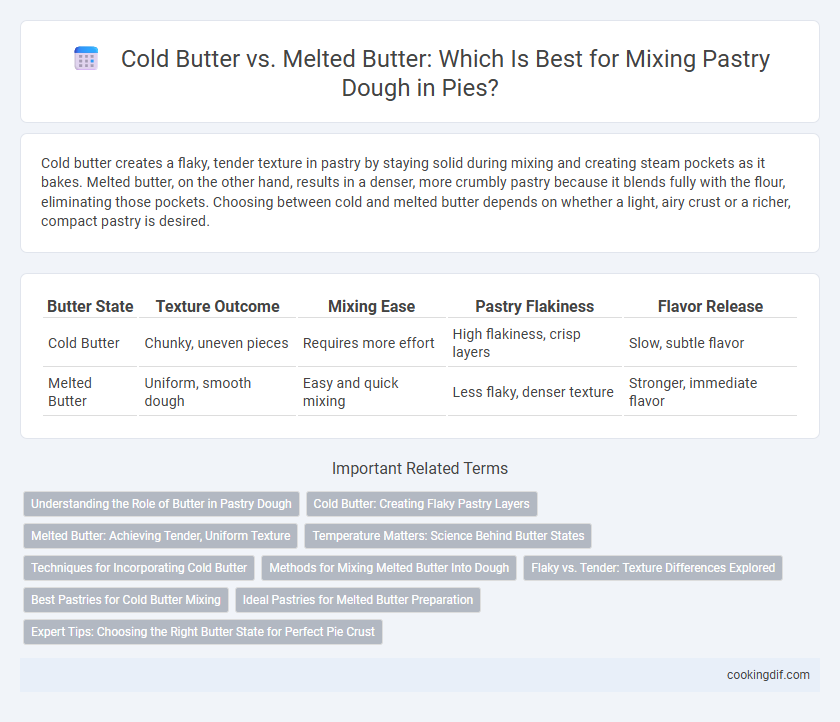Cold butter creates a flaky, tender texture in pastry by staying solid during mixing and creating steam pockets as it bakes. Melted butter, on the other hand, results in a denser, more crumbly pastry because it blends fully with the flour, eliminating those pockets. Choosing between cold and melted butter depends on whether a light, airy crust or a richer, compact pastry is desired.
Table of Comparison
| Butter State | Texture Outcome | Mixing Ease | Pastry Flakiness | Flavor Release |
|---|---|---|---|---|
| Cold Butter | Chunky, uneven pieces | Requires more effort | High flakiness, crisp layers | Slow, subtle flavor |
| Melted Butter | Uniform, smooth dough | Easy and quick mixing | Less flaky, denser texture | Stronger, immediate flavor |
Understanding the Role of Butter in Pastry Dough
Cold butter creates flaky layers in pastry dough by maintaining solid fat pockets that release steam during baking, resulting in a tender texture. Melted butter incorporates fully into the dough, producing a denser, less flaky crust due to the absence of distinct fat layers. Understanding the temperature and form of butter is crucial for achieving desired pastry characteristics, with cold butter favored for flakiness and melted butter for a softer crumb.
Cold Butter: Creating Flaky Pastry Layers
Cold butter is essential for creating flaky pastry layers because it remains solid during mixing, allowing small chunks to stay intact within the dough. These butter pockets release steam during baking, which puffs the dough and forms distinct flaky layers. Using cold butter prevents over-absorption into the flour, maintaining a tender, layered texture in pie crusts.
Melted Butter: Achieving Tender, Uniform Texture
Melted butter in pastry mixing promotes a tender, uniform texture by evenly distributing fat throughout the dough, preventing hard spots and ensuring consistent moisture. This method allows the gluten strands to develop less, resulting in a softer, more pliable crust ideal for delicate pies. Using melted butter also simplifies incorporation with other ingredients, enhancing overall dough cohesion and bake quality.
Temperature Matters: Science Behind Butter States
Cold butter maintains its solid state, creating distinct layers in pastry dough that result in a flaky texture by releasing steam during baking. Melted butter, with a liquid consistency, integrates fully into the dough, producing a denser and less flaky crust due to the lack of steam pockets. Understanding the temperature-dependent physical state of butter is crucial for achieving the desired pie crust consistency and texture through precise mixing methods.
Techniques for Incorporating Cold Butter
Cold butter is best incorporated into pastry dough using techniques like cutting or rubbing the butter into the flour to create a crumbly texture that ensures flakiness. Using a pastry cutter or food processor helps maintain butter's solid state, preventing premature melting that can result in dense pastry. Small, evenly distributed butter pieces create steam during baking, forming layers and a tender, crisp crust essential for high-quality pie dough.
Methods for Mixing Melted Butter Into Dough
Mixing melted butter into pastry dough creates a tender, flaky texture by coating flour proteins and reducing gluten formation. Methods include incorporating melted butter gradually with cold liquids to maintain dough temperature or blending it directly into dry ingredients before adding water, ensuring even fat distribution. This technique differs from cold butter methods, which rely on solid fat pieces to create distinct flakes during baking.
Flaky vs. Tender: Texture Differences Explored
Cold butter creates steam during baking, which forms distinct layers in pastry, resulting in a flaky texture ideal for pies. Melted butter blends into the dough uniformly, leading to a tender and crumbly crust but less pronounced layering. Choosing cold butter preserves structure and flakiness, while melted butter enhances softness and richness in pie crusts.
Best Pastries for Cold Butter Mixing
Cold butter is essential for flaky pastries such as pie crusts, biscuits, and puff pastry because it creates distinct layers by steaming the butter during baking, resulting in a light and tender texture. For recipes like pie crusts, using cold butter helps prevent the dough from becoming greasy and tough, ensuring optimal flakiness. Pastries like scones and shortcrust pastry benefit greatly from cold butter mixing due to the controlled fat distribution that promotes a crisp, crumbly bite.
Ideal Pastries for Melted Butter Preparation
Melted butter is ideal for pastries requiring a tender, crumbly texture like shortcrust and sable doughs, where its liquid state helps evenly distribute fat and moisture throughout the flour. This method enhances flakiness and prevents the toughness often caused by overworking dough with cold butter. Pastries such as pie crusts, tarts, and cookie bases benefit from melted butter to achieve a delicate, melt-in-the-mouth consistency.
Expert Tips: Choosing the Right Butter State for Perfect Pie Crust
Cold butter creates flaky pie crusts by retaining small pockets of fat that steam during baking, resulting in tender layers, while melted butter produces a denser, less flaky texture due to even fat distribution. Expert bakers recommend using chilled butter cut into small cubes when mixing pastry to ensure optimal flakiness and texture. Precision in butter temperature and handling is crucial for achieving the ideal pie crust that balances crispness and tenderness.
Cold butter vs melted butter for pastry mixing Infographic

 cookingdif.com
cookingdif.com